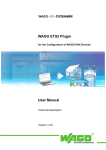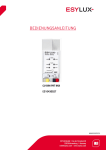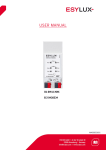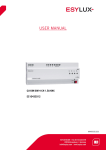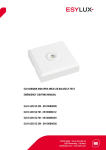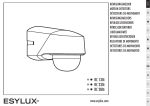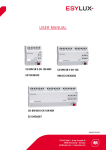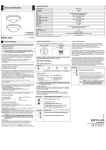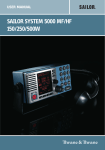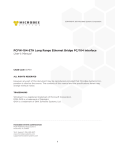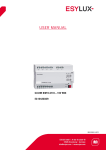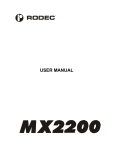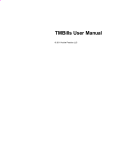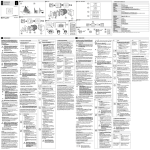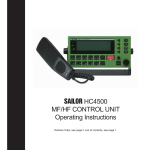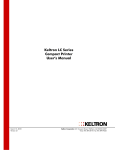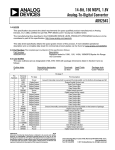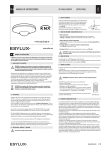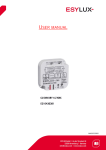Download 3.14 CU-DIN IPRT KNX as line coupler
Transcript
USER MANUAL CU-DIN IPRT KNX EC10430527 CU-DIN IPRT KNX EC10430527 MA00653501 USER MANUAL Table of contents 1 Description ................................................................................................3 2 Safety instructions ......................................................................................5 3 Product Funtion .........................................................................................5 3.1 3.2 3.3 3.4 3.5 3.6 3.7 3.8 3.9 3.10 3.11 3.12 3.13 3.14 3.14 3.15 4 Communication objects .................................................................... 5 CU-DIN IPRT KNX as programming interface ...................................... 5 Tunnelling ...................................................................................... 5 Routing .......................................................................................... 6 Coupler .......................................................................................... 6 Dimension drawings ........................................................................ 7 Function description ........................................................................ 7 Normal mode .................................................................................. 8 Function button .............................................................................. 8 Addressing mode............................................................................. 9 Operation modes ............................................................................. 9 Boot mode...................................................................................... 9 KNX Telegrams in the network ........................................................ 10 CU-DIN IPRT KNX as Area coupler .................................................. 10 CU-DIN IPRT KNX as line coupler ................................................... 12 CU-DIN IPRT KNX in mixed System ................................................ 13 Technical Data .........................................................................................14 4.1 State of delivery ............................................................................ 15 5 Application Description .............................................................................16 6 ETS-Parameters .......................................................................................17 6.1 7 Windows presentation ...............................................................................26 7.1 7.2 8 Properties..................................................................................... 17 6.1.1 General ............................................................................ 18 6.1.2 IP Configuration ................................................................ 18 6.1.3 KNX multicast address ....................................................... 20 6.1.4 Settings for coupler............................................................ 21 6.1.5 Main Line ......................................................................... 22 6.1.6 Sub line ........................................................................... 24 Boot mode.................................................................................... 26 Normal mode ................................................................................ 27 Web front-end ..........................................................................................29 CU-DIN IPRT KNX 1 / 31 USER MANUAL 9 Product disposal ......................................................................................30 10 ESYLUX manufacturer´s guarantee .............................................................30 CU-DIN IPRT KNX 2 / 31 USER MANUAL 1 Description IP Routers are similar to TP line couplers, except that they use Ethernet for the main line. However, it is also possible to directly integrate KNX end devices via IP, making Ethernet respectively IP (Internet Protocol) a KNX medium in its own right. The ESYLUX CU-DIN IPRT KNX is a tunnelling and routing device. It can be used as line- or backbone coupler and provides a data connection between the upper KNXnet/IP line (main line or backbone) and the lower TP KNX bus line (sub line). It also provides with the tunnelling protocol a connection point for ETS to enable commissioning and monitoring. CU-DIN IPRT KNX can also connect two separate installations/systems. Following highlights are characterizing ESYLUX CU-DIN IPRT KNX Router: Support of long messages up to 250 byte. In combination with ESYLUX line coupler CU-DIN LC KNX and ESYLUX USB interface “UIM-KNX 42” long messages are made possible (e.g. energy metering applications). It provides the tunnelling protocol, a connection point for ETS to enable commissioning and monitoring (4 parallel connections are possible). CU-DIN IPRT KNX can be used for replacing a line coupler or an area coupler. The best advantage of this change is using LAN as a fast medium for exchange of telegrams between the lines and/or areas. Sending IAK on own message: sending of immediate acknowledged (IACK) on a frame that is sent by the ESYLUX device itself. When the CU-DIN IPRT KNX sends a message and there is nobody to acknowledge this message, the CU-DIN IPRT KNX would repeat the last message up to 3 times. In case there is an IACK, there will be no repetition. The failure mechanism in case of a negative IACK or BUSY is still maintained. Switching off the filter table with a button on the device without reconfiguring the device with ETS, necessary for fast diagnostic on site. It can temporarily disable filtering of messages by pressing a button. This eases commissioning and debugging of the system. The temporary access to other lines is possible without download from ETS. Automatically switching on filter tables and filtering of device oriented tables after time out. Time out is ETS configurable. No forgetting of reactivating the tables anymore. CU-DIN IPRT KNX 3 / 31 USER MANUAL Routing of all physically addressed messages (no filtering of device oriented messages), no matter of own physical address, on press of a button on the device without reconfiguring the device with ETS. High internal amount of communication buffers capable smoothing peeks in communication load. Detailed possibility for diagnosis by displaying all operational states with 6 duo LEDs. (Bus OK (each line), traffic (each line), errors/faulty communication NACK, BUSY on the bus (each line), state of the filter table …) UPnP available to discover the device in IP network. The ETS can discover the device as communication interface through EIB net/IP Search Request. WEB interface: currently providing device settings and an opportunity to switch on to program mode. The firmware can be updated through the web interface. Wide power supply voltage. Modular installation device for 35mm DIN rails. Note: Please note that commissioning straight at delivery status (default settings) means: The IP coupler does block all telegrams because the filter table is not defined, The fall-back time after manual operation is 120 min and The physical address is 15.15.0. Note: Use this product only as intended (as described in the user instructions). Do not make any changes or alterations as this will render any warrantees null and void. You should check the device for damage immediately after unpacking it. If there is any damage, you should not install the device under any circumstances. If you suspect that safe operation of the device cannot be guaranteed, you should turn the device off immediately and make sure that it cannot be operated unintentionally. CU-DIN IPRT KNX 4 / 31 USER MANUAL 2 Safety instructions Work on the 230 V power system must be carried out by authorized personnel only, with due regard to the applicable installation regulations. Switch off the power supply before installing the system. The 21–30 V KNX bus voltage cannot be used as 24 V operating or auxiliary voltage. Please observe the installation instructions for the SELV protective measure. 3 Product Funtion 3.1 Communication objects CU-DIN IPRT KNX has no KNX communication objects. 3.2 CU-DIN IPRT KNX as programming interface CU-DIN IPRT KNX can be used together with the ETS as a programming interface. The device provides an additional physical address for this purpose which can be used for a tunnelling connection. 3.3 Tunnelling The presence of the Internet Protocol (IP) has led to the definition of KNXnet/IP. KNXnet/IP provides the means for point-to-point connections -KNXnet/IP Tunnelling- for ETS and/or between a supervisory system and a KNX installation. KNXnet/IP Device Management provides configuration of KNXnet/IP devices through the KNX network effectively reducing the time required for configuration. CU-DIN IPRT KNX 5 / 31 USER MANUAL 3.4 Routing Routing is how lines or areas may interconnect using IP networks via KNXnet/IP. KNXnet/IP Routing defines how KNXnet/IP routers communicate with each other using IP networks. 3.5 Coupler The basic functionality of CU-DIN IPRT KNX is coupling the Ethernet with KNXTP line(s). CU-DIN IPRT KNX provides galvanic isolation between the two connected lines. Due to the flexibility of CU-DIN IPRT KNX, the coupler can be used as a line coupler e.g. to connect trough Ethernet several TP lines together, as a backbone coupler to connect trough Ethernet several TP areas or to connect different TP installations/systems. The main task of CU-DIN IPRT KNX is filtering the traffic according the installation place in the hierarchy or according to the built-in filter tables for group oriented communication. The CU-DIN IPRT KNX provides outstanding features compared to other similar products, for example support for long messages (up to 250 byte length) and a configurable one button activation of special functions (e.g. transmit all group telegrams). These are helpful during installation, during run time and for trouble shooting. The high informative 6 duo LED display shows accurate the bus status on each line. This helps identifying common communication problems due to bus load or retransmissions on both lines. CU-DIN IPRT KNX 6 / 31 USER MANUAL 3.6 Dimension drawings 3.7 Function description 1. LED Bus Stat LAN 2. LED Bus Stat KNX 3. LED Traffic LAN 4. LED Traffic KNX 5. Routing of group telegrams* 6. Routing of physical addressed telegrams* 7. Function button 8. Programming LED 9. Programming button *LEDs are not used for “IP-Interface”. CU-DIN IPRT KNX 7 / 31 USER MANUAL 3.8 Normal mode Green Red LED 1 Bus Stat LAN Off: LAN line error On: LAN line OK On: manual overwrite active LED 2 Bus Stat KNX Off: KNX line error or not connected On: KNX line OK LED 3 Traffic LAN Blinking: bus traffic on LAN line Off: no traffic on LAN line Speed up to 10 Mbit/s Blinking: transmission error on LAN line LED 4 Traffic KNX Blinking: bus traffic on KNX line Off: no traffic on KNX line Blinking: transmission error on KNX line LED 5 Group Address Routing of group telegrams Off: LAN and KNX different Filter table active Block Green and red: route all LED 6 Physical Address Routing of physical addressed telegrams Off: LAN and KNX different Filter table active Yellow: block Green and yellow: route all 3.9 Function button Long press (3 sec) Switch to manual override. Default function is set with LAN line and (KNX) line parameter. Manual override functionality is configured in “General parameters”. Note: The latest downloaded settings (parameters) and filter table are still available after switching back from “Manual operation” to “Normal operation”. CU-DIN IPRT KNX 8 / 31 USER MANUAL Very long press (15s) LEDs: LEDs are on red release button and press again for some sec: resets all the parameter to factory default (incl. physical address). 3.10 Addressing mode LED addressing mode Off: normal operating mode On: addressing mode After receiving the physical address the CU-DIN IPRT KNX automatically returns from addressing mode to the normal operating mode. Button addressing mode Button for switching between normal operating mode and addressing mode for assigning the physical address. 3.11 Operation modes CU-DIN IPRT KNX Router can only support one mode at one time, either Link layer mode or bus monitoring mode. The IP-Router uses in its normal operation as router the Link layer mode. That way it cannot switch to the bus monitoring mode otherwise the routing functionality is no longer possible. 3.12 Boot mode To enter the boot mode: Disconnect the DC power supply, Keep both "function button" and "programming button" pressed and connect the DC power supply. The device enters in “boot mode” in the next situations: If after a communication error in the LAN line (traffic LAN LED lighting in red) you try to reset the application (pressing the “manual function” button for 15 seconds). CU-DIN IPRT KNX 9 / 31 USER MANUAL If you try to reset the application (pressing the “manual function” button for 15 seconds) having the Ethernet cable disconnected. To remove the “boot mode” it is necessary to enter in the web interface and update the firmware or reset the application after pressing the “Abort” button. 3.13 KNX Telegrams in the network The IP Router sends telegrams from/to the KNX to/from the IP network in accordance with the KNXnet/IP protocol specification. These telegrams are sent in the default setting as multicast telegrams to the multicast IP address 224.0.23.12 port 3671. The Multicast IP address 224.0.23.12 is the defined address for the KNXnet/IP from the KNX Association in conjunction with the IANA. This address should stay as defined and only changed if it becomes necessary due to the existing network. By commissioning, it should be regarded that all KNX IP devices which should communicate with one another via IP must use the same IP routing multicast address.Settings are to be changed in the “General Parameters”. Note: Multicast IP address 224.0.23.12 may need to be enabled corresponding to the type of network and the setting of the network components. 3.14 CU-DIN IPRT KNX as Area coupler CU-DIN IPRT KNX in a KNX system can assume the function of an area coupler. For this purpose it must receive the physical address of an area coupler (1.0.0 till 15.0.0). For now in the actual ETS, up to 15 areas can be defined with area couplers. The following illustration shows the topology with CU-DIN IPRT KNX routers as area couplers and CU-DIN LC KNX couplers as line couplers. CU-DIN IPRT KNX 10 / 31 USER MANUAL IP-L: IP time KNX-L: KNX line BC: Backbone-coupler ML: Main line SL: Sub line CU-DIN IPRT KNX 11 / 31 USER MANUAL 3.14 CU-DIN IPRT KNX as line coupler CU-DIN IPRT KNX in a KNX system can assume the function of a line coupler. For this purpose it must receive the physical address of a line coupler (1.1.0 till 15.15.0). For now in the actual ETS, up to 225 lines can be defined (1.1.0 till 15.15.0). The following illustration shows the topology with CU-DIN IPRT KNX routers as line couplers. IP-L: IP line KNX-L: KNX line IPRT: Line coupler CU-DIN IPRT KNX 12 / 31 USER MANUAL 3.15 CU-DIN IPRT KNX in mixed System If it is necessary in a KNX system to use the CU-DIN IPRT KNX at one point as an area coupler, e.g. office complex, and at another point as a line coupler, e.g. a remote underground garage; this is possible. It is only necessary to ensure that the CU-DIN IPRT KNX used as a line coupler uses a line coupler address from a free area. IP-L: IP line KNX-L: KNX line BC: Backbone coupler IPRT: Line coupler ML: Main line SL: Sub line CU-DIN IPRT KNX 13 / 31 USER MANUAL Note: If a KNX/USB or KNX/IP interface is used to program a device in another line connected to a KNX IP Router, you should pay close attention to have a correct topology! 4 Technical Data Supply voltage 24V (12 - 30V) or 12 - 24V~ Current consumption from KNX Typ. 5 mA Current consumption Typ. 190 mA Power consumption Typ. 520mW, max 800mW Rated voltage / Rated current Supply (V) 11 15 20 24 31 Connections IP line: RJ45 socket for 10/100BaseT, IEEE 802.3 networks KNX line: KNX Wago bus connecting terminal (red/black) screw less for single-core cable Ø 0,6 to 0,8 mm Display elements LED Power LED LAN-OK I typ. (mA) 45 33 25,3 21,6 18 P typ. (W) 0,495 0,495 0,506 0,5184 0,558 LED Error LED KNX-OK LED KNX-RX/TX LED LANRX/TX LED for programming mode Control elements Function button, Programming button Installation on 35 mm DIN rail mount Type of protection IP 20 according to EN 60529 CU-DIN IPRT KNX 14 / 31 USER MANUAL Bus Safety extra low voltage 21…30V SELV Housing colour Plastic PA66 housing grey Dimensions DIN-rail mounted device H= 90mm, W= 36mm (2 SU), D= 70mm Mounting depth 64 mm Weight 66 g Temperature range Operation: -5°C… +45°C non-condensing Storage: -20°C… +60°C Relative humidity 5% -93% non-condensing CE Mark in accordance with EMC Standard 2004/1008/EC RoHS 2011/65/EU 4.1 State of delivery Note: Every CU-DIN IPRT KNX Router is delivered with these default parameters. Every device will be sent with its own MAC address. Physical address 15.15.0 Physical address for tunnelling connections 15.15.255 IP address DHCP IP address assignment from DHCP service IP routing multicast address 224.0.23.12 IP subnet mask DHCP IP standard gateway DHCP IP to KNX Group telegrams 0-13 Filter Main group telegrams 14-15 Transmit all Physical telegrams Filter KNX to IP CU-DIN IPRT KNX 15 / 31 USER MANUAL Group telegrams 0-13 Filter Main group telegrams 14-15 Transmit all Physical telegrams Filter Physical: Repetition if errors on sub normal Group: Repetition if errors on sub line normal Telegram confirmations on line if routed Send confirmation on own no line 5 telegrams Application Description If the coupler receives telegrams (for example during commissioning) which use a physical address as destination address, it compares the physical addresses of the receiver with its own physical address and then decides whether it must route the telegrams or not. The coupler reacts to telegrams with group addresses in accordance with its parameter settings. During normal operation (default setting), the coupler only routes those telegrams whose group addresses have been entered in its filter table. If the coupler routes a telegram and does not receive an acknowledgement, or if a bus device finds a transmission error, the coupler repeats the telegram three times. With the parameters „Repetitions if errors...“, this behaviour can be set separately for both lines. These parameters should be left in the default setting. Note: ETS does not provide an unload procedure for the application of the IPRouter. CU-DIN IPRT KNX 16 / 31 USER MANUAL 6 ETS-Parameters 6.1 Properties Properties Note: After loading the IP-Parameter and the device name over the ETS a manual restart has to be executed. CU-DIN IPRT KNX 17 / 31 USER MANUAL 6.1.1 General Fig. 1: General ETS-Text Range [Default value] Comment Host name ZYXW [KNX IP Router] Field to enter the CU-DIN IPRT KNX name (30 signs max.). For an easy search of the device with the ETS or with a KNXnet/IP visualisation system. Enable slow connections enable disable [disable] Enable to support slow tunnelling connections Table 1: Parameter General 6.1.2 IP Configuration Fig. 2: DHCP configuration CU-DIN IPRT KNX 18 / 31 USER MANUAL ETS-Text Range [Default value] Comment DHCP use do not use [use] If DHCP is used, no parameterisation needed. If DHCP is not used, following parameters are to be set. Table 2: DHCP configuration Fig. 3: DHCP manual configuration ETS-Text Range [Default value] Comment DHCP configuration [Byte1]. [Byte2]. [Byte3]. [Byte4] use do not use [use] If DHCP is not used, following parameters are to be set. IP Address IP Byte 1 IP Byte 2 CU-DIN IPRT KNX IP Byte 1 to 4: manual input. 0…255 0…255 19 / 31 USER MANUAL IP Byte 3 IP Byte 4 Net NM NM NM NM mask Byte 1 Byte 2 Byte 3 Byte 4 Gateway GW Byte GW Byte GW Byte GW Byte 1 2 3 4 0…255 0…255 0…255 0…255 0…255 0…255 0…255 0…255 0…255 0…255 Net mask Byte 1 to 4: manual input. Gateway Byte 1 to 4: manual input. Table 3: DHCP manual configuration 6.1.3 KNX multicast address Fig. 4: KNX multicast address ETS-Text Range [Default value] Comment Byte 1 [224 … 239] 224…239 System: [224] Individual: [239] First byte of the IP routing multicast address. If System multicast address used: "224" is permanently set. If Individual multicast address used: "239" is permanently set. Byte 2 [0 … 255] 0…255 Second byte of the IP CU-DIN IPRT KNX 20 / 31 USER MANUAL [0] routing multicast address. Can only be set manually if an individual multicast address is used. Byte 3 [0 … 255] 0…255 [23] Third byte of the IP routing multicast address. Can only be set manually if an individual multicast address is used. Byte 4 [0 … 255] 0…255 [12] Fourth byte of the IP routing multicast address. Can only be set manually if an individual multicast address is used. Table 4: KNX multicast address Note: The Multicast IP address 224.0.23.12 is the defined address for the KNXnet/IP from the KNX Association in conjunction with the IANA. This address should stay as defined and only changed if it becomes necessary due to the existing network. By commissioning, it should be regarded that all KNX IP devices which should communicate with one another via IP must use the same IP routing multicast address. 6.1.4 Settings for coupler Fig. 5: Settings for coupler CU-DIN IPRT KNX 21 / 31 USER MANUAL ETS-Text Range [Default value] Comment Fallback time for manual operation 10 min, 1 hour, 4 hours, 8 hours [1 hour] Time duration required to exit from “manual operation” Manual function Disabled Pass all telegrams Pass physical telegrams Pass group telegrams [pass all telegrams] Telegram routing configuration for the manual function. Table 5: Parameter General 6.1.5 Main Line Fig. 6: Main Line/Configuration Fig. 6.1: Main Line/Group or physical telegrams configured individually CU-DIN IPRT KNX 22 / 31 USER MANUAL ETS-Text Range [Default value] Comment Configuration groups: filter, physical: block groups, physical: filter groups: route, physical: filter groups, physical: route configure [groups, physical: filter] Block: no telegram is routed. Filter: Only telegrams are routed which are entered in the filter table. Route: the telegrams are routed. Configure: the following parameters can be set individually. This parameter is to be set depending on the planed configuration. Group telegrams 1. transmit all (for testing only) 2. block 3. filter [filter] 1. All group telegrams are transmitted. 2. No group telegram is transmitted. 3. Only group telegrams are routed which are entered in the filter table. The ETS 3/4 produces the filter table automatically. Main group telegrams 14/15 1. transmit all 2. block [transmit all] 1. Group telegrams with the main group 14 or 15 (e.g. 14/1) are routed. 2. Group telegrams with the main group 14 or 15 (e.g. 14/1) are not routed. Physical telegrams 1. transmit all (for testing only) 2. block 3. filter [filter] 1. All physical telegrams are transmitted. 2. No physical telegram is transmitted. 3. Only physical telegrams are routed based on physical address. Table 6: Main Line Note: Please note that the parameter “transmit all” for Group or Physical telegrams is intended only for testing purposes and it should not be set for normal operation. CU-DIN IPRT KNX 23 / 31 USER MANUAL 6.1.6 Sub line Fig. 7: Sub line ETS-Text Range [Default value] Comment Configuration groups: filter, physical: block groups, physical: filter groups: route, physical: filter groups, physical: route configure [groups, physical: filter] Block: no telegram is routed. Filter: Only telegrams are routed which are entered in the filter table. Route: the telegrams are routed. Configure: the following parameters can be set individually. This parameter is to be set depending on the planed configuration. Group telegrams 1. transmit all (for testing only) 2. block 3. filter [filter] 1. All group telegrams are transmitted. 2. No group telegram is transmitted. 3. Only group telegrams are routed which are entered in the filter table. The ETS 3/4 produces the filter table automatically. CU-DIN IPRT KNX 24 / 31 USER MANUAL Sub group telegrams 14/15 1. transmit all 2. block [transmit all] 1. Group telegrams with the sub group 14 or 15 (e.g. 14/1) are routed. 2. Group telegrams with the sub group 14 or 15 (e.g. 14/1) are not routed. Physical telegrams 1. transmit all (for testing only) 2. block 3. filter [filter] 1. All physical telegrams are transmitted. 2. No physical telegram is transmitted. 3. Only physical telegrams are routed based on physical address. Physical: Repetition if errors on sub line 1. no 2. normal 3. reduced [normal] If a transmission error (e.g. due to missing receiver) is found when sending a physical telegram on the sub line: 1. The physical telegram is not repeated. 2. The physical telegram is repeated up to 3 times. 3. The physical telegram will be repeated only one time. Group: Repetition if errors on sub line 1. no 2. normal 3. reduced [normal] If a transmission error (e.g. due to missing receiver) is found when sending a group telegram on the sub line: 1. The group telegram is not repeated. 2. The group telegram is repeated up to 3 times. 3. The group telegram will be repeated only one time. Telegram confirmations on line 1. if routed 2. always [if routed] 1. Only telegrams which are to be routed are confirmed on the sub line (ACK). 2. Each telegram on the sub line is confirmed (ACK). Send confirmation on own telegrams 1. yes 2. no [no] 1. Every telegram on the sub line is confirmed with its own ACK (from the Line coupler). 2. No confirmation with own ACK Table 7: Sub Line Note: If the parameter “Send confirmation on own telegrams” is set yes, CU-DIN IPRT KNX will send an ACK systematically when sending any own routed telegram. CU-DIN IPRT KNX 25 / 31 USER MANUAL 7 Windows presentation 7.1 Boot mode CU-DIN IPRT KNX 26 / 31 USER MANUAL 7.2 Normal mode CU-DIN IPRT KNX 27 / 31 USER MANUAL CU-DIN IPRT KNX 28 / 31 USER MANUAL 8 Web front-end Web front-end usage: Please use the Web front-end directly on the device to load the firmware in the device. Therefor the device has to be opened over network in Windows 7 (or higher) as UPnP network device. Alternatively you can use the device name as URI base: http://KNX-IP[type]-[XX][YY][ZZ]:8080/update.shtml with the following parameters without brackets [ ] CU-DIN IPRT KNX 29 / 31 USER MANUAL [type] = “rt” for router, “if” for interface [XX] = byte 4 of the MAC address, listed on the label at the housing [YY] = byte 5 of the MAC address [ZZ] = byte 6 of the MAC address Note: This works only if the DHCP is enabled (to be changed in the ETS parameters if necessary). Example for device with MAC D0-76-50-11-22-33: Router: http://KNX-IPrt-112233:8080 Interface: http://KNX-IPif-112233:8080 Please follow the hints on the Web front-end. 9 Product disposal This device must not be disposed of as unsorted household waste. Used devices must be disposed of correctly. Contact your local town council for more information. 10 ESYLUX manufacturer´s guarantee ESYLUX products are tested in accordance with applicable regulations and manufactured with the utmost care. The guarantor, ESYLUX Deutschland GmbH, Postfach 1840, D-22908 Ahrensburg, Germany (for Germany) or the relevant ESYLUX distributor in your country (visit www.esylux.com for a complete overview) provides a guarantee against manufacturing/material defects in ESYLUX devices for a period of three years from the date of manufacture. This guarantee is independent of your legal rights with respect to the seller of the device. The guarantee does not apply to natural wear and tear, changes/interference caused by environmental factors or damage in transit, nor to damage caused as a result of failure to follow the user or maintenance instructions and/or as a result of improper installation. Any illuminants or batteries supplied with the device are not covered by the guarantee. The guarantee can only be honoured if the device is sent back with the invoice/receipt, unchanged, packed and with sufficient postage to the guarantor, CU-DIN IPRT KNX 30 / 31 USER MANUAL along with a brief description of the fault, as soon as a defect has been identified. If the guarantee claim proves justified, the guarantor will, within a reasonable period, either repair the device or replace it. The guarantee does not cover further claims; in particular, the guarantor will not be liable for damages resulting from the device’s defectiveness. If the claim is unfounded (e.g. because the guarantee has expired or the fault is not covered by the guarantee), then the guarantor may attempt to repair the device for you for a fee, keeping costs to a minimum. CU-DIN IPRT KNX 31 / 31
































